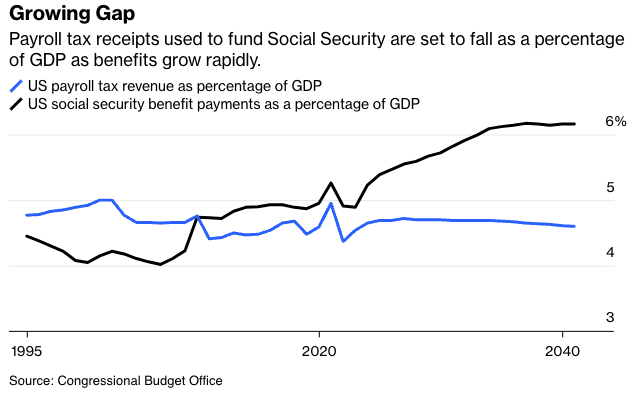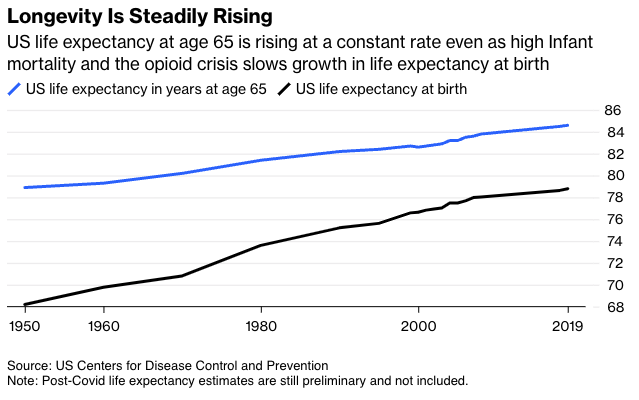Republicans in Congress have proposed a plan to shore up the Social Security Trust Fund, mainly by slowly increasing the retirement age from 67 to 69. Despite an immediate objection from President Joe Biden and top Democrats, raising the retirement age is crucial to the long-term health of Social Security.
As recently as 2020 Social Security took in more revenue than it paid in benefits. But the tables have turned, and the federal government expects the program take in $1.17 trillion this year and pay out $1.32 trillion. The $150 billion shortfall will be made up by drawing down on the program’s $2.63 trillion trust fund.
That $150 billion may seem manageable, but the problem grows larger each year. By 2032, the government expects benefits to exceed revenues by about $500 billion annually. If we do nothing, the Social Security Trust Fund will be exhausted by 2034. If it gets to that point, the law requires a 23% cut in benefits across the board to ensure money coming into the program equals that flowing out.

No one wants to see benefits cut. The financial shock to seniors would be enormous. Yet, unless some radical measures are taken, cuts will be almost impossible to avoid. Raising the retirement age to 69 would bring the annual growth of Social Security costs in line with the annual increase in revenue by 2030, according to an analysis by the Committee for a Responsible Federal Budget.
It’s not like such a move would be unprecedented. When Social Security last faced an insolvency crisis, in 1983, Congress passed a bipartisan solution that included raising the retirement age from 65 to 67 in recognition of increasing lifespans. The same rationale remains true today. Between 1950 and 1980, the life expectancy of 65-year-olds increased by 2.5 years from 78.9 to 81.4. From 1980 to 2019, it increased an additional 3.2 years to 84.6.

Critics argue that raising the retirement age unfairly punishes the poor because the life expectancy of lower-income Americans has risen far less than that of higher-income Americans. However, life expectancy is only one part of the picture. What also must be considered is the total amount retirees can expect to receive.
Under the Republican proposal, the lowest-quintile group by income could expect to receive more in benefits than they pay in contributions, while it’s the opposite for the highest-quintile group. Consider an analysis of rising life expectancies by the Social Security Administration in 2009 that found the lowest-income quintile participating in the Social Security system saw their lifetime benefits boosted by about 12%. On the other hand, the highest-income quintile saw their lifetime incomes fall by 1.3%.
Moreover, this gap has grown over time. Over the past 25 years, the highest quintile has seen its net benefits shrink by 2.6 percentage points, while the net benefits for the lowest quintile have remained steady. So, even as higher-income Americans live longer, their Social Security return is declining.
There are a few reasons for this. First, Social Security benefits are taxable for higher income Americans. Second, much of the reduction in life expectancies for poor Americans is related to the opioid crisis, which primarily impacts Americans under 65. Finally, the program is fundamentally designed to provide a greater return on contributions from lower-income Americans.
Rather than raising the retirement age, Biden would seek to extend the life of Social Security through tax increases on those making more than $400,000 a year, in effect repealing the Trump administration tax cuts for that group of Americans, a move that would boost revenues by about $125 billion annually. Yet, that would still not cover even this year's shortfall, and would only extend solvency by a few years. In contrast, raising the retirement age would create savings that grow over time.
Stabilizing Social Security’s finances has long been one of Congress's most challenging tasks. The sole major successful effort, the 1983 reform, was predicated on recognizing that longer lifespans necessitated an increase in the retirement age. Biden and leading Democrats must accept that the same reality holds true today even if it jeopardizes his re-election campaign. It’s the least bad option.
Karl W. Smith is a Bloomberg Opinion columnist. Previously, he was vice president for federal policy at the Tax Foundation and assistant professor of economics at the University of North Carolina.
This article was provided by Bloomberg News.








